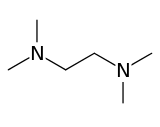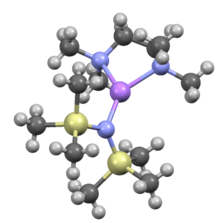Tetramethylethylenediamine
Tetramethylethylenediamine (TMEDA or TEMED) is a chemical compound with the formula (CH3)2NCH2CH2N(CH3)2. This species is derived from ethylenediamine by replacement of the four amine hydrogens with four methyl groups. It is a colorless liquid, although old samples often appear yellow. Its odor is remarkably similar to that of rotting fish.[3]
 | |
 | |
| Names | |
|---|---|
| Other names
N,N,N′,N′-Tetramethylethane-1,2-diamine[1] | |
| Identifiers | |
3D model (JSmol) |
|
| Abbreviations | TMEDA, TEMED |
| 1732991 | |
| ChEBI | |
| ChemSpider | |
| ECHA InfoCard | 100.003.405 |
| EC Number |
|
| 2707 | |
| MeSH | N,N,N',N'-tetramethylethylenediamine |
PubChem CID |
|
| RTECS number |
|
| UNII | |
| UN number | 2372 |
CompTox Dashboard (EPA) |
|
| |
| |
| Properties | |
| C6H16N2 | |
| Molar mass | 116.208 g·mol−1 |
| Appearance | Colorless liquid |
| Odor | Fishy, ammoniacal |
| Density | 0.7765 g mL−1 (at 20 °C) |
| Melting point | −58.6 °C; −73.6 °F; 214.5 K |
| Boiling point | 121.1 °C; 249.9 °F; 394.2 K |
| Miscible | |
| Acidity (pKa) | 8.97 |
| Basicity (pKb) | 5.85 |
Refractive index (nD) |
1.4179 |
| Hazards | |
| Safety data sheet | See: data page |
| GHS pictograms |    |
| GHS Signal word | Danger |
GHS hazard statements |
H225, H302, H314, H332 |
| P210, P280, P305+351+338, P310 | |
| NFPA 704 (fire diamond) | |
| Flash point | 20 °C (68 °F; 293 K) |
| Explosive limits | 0.98–9.08% |
| Lethal dose or concentration (LD, LC): | |
LD50 (median dose) |
|
| Related compounds | |
Related amines |
Triethylenetetramine |
Related compounds |
|
| Supplementary data page | |
| Refractive index (n), Dielectric constant (εr), etc. | |
Thermodynamic data |
Phase behaviour solid–liquid–gas |
| UV, IR, NMR, MS | |
Except where otherwise noted, data are given for materials in their standard state (at 25 °C [77 °F], 100 kPa). | |
| Infobox references | |
As a reagent in organic and inorganic synthesis
TMEDA is widely employed as a ligand for metal ions. It forms stable complexes with many metal halides, e.g. zinc chloride and copper(I) iodide, giving complexes that are soluble in organic solvents. In such complexes, TMEDA serves as a bidentate ligand.
TMEDA has an affinity for lithium ions.[3] When mixed with n-butyllithium, TMEDA's nitrogen atoms coordinate to the lithium, forming a cluster of higher reactivity than the tetramer or hexamer that n-butyllithium normally adopts. BuLi/TMEDA is able to metallate or even doubly metallate many substrates including benzene, furan, thiophene, N-alkylpyrroles, and ferrocene.[3] Many anionic organometallic complexes have been isolated as their [Li(tmeda)2]+ complexes.[4] In such complexes [Li(tmeda)2]+ behaves like a quaternary ammonium salt, such as [NEt4]+.
 TMEDA adduct of lithium bis(trimethylsilyl)amide Notice that the diamine is a bidentate ligand.[5]
TMEDA adduct of lithium bis(trimethylsilyl)amide Notice that the diamine is a bidentate ligand.[5]
It is also worth noting that s-BuLi/TMEDA is also a useful combination in organic synthesis. Utilization of this is useful in cases where the n-butyl anion is able to add into the starting material due to its weak nucleophilic nature. TMEDA is still capable of forming a metal complex with Li in this case as mentioned above.
Other uses
TEMED is used with ammonium persulfate to catalyze the polymerization of acrylamide when making polyacrylamide gels, used in gel electrophoresis, for the separation of proteins or nucleic acids. Although the amounts used in this technique may vary from method to method, 0.1–0.2% v/v TEMED is a "traditional" range. TEMED can also be a component of hypergolic propellants.
References
- "N,N,N′,N′-tetramethylethylenediamine – Compound Summary". PubChem Compound. USA: National Center for Biotechnology Information. 16 September 2004. Retrieved 30 June 2012.
- "MSDS" (PDF).
- Haynes, R. K.; Vonwiller, S. C.; Luderer, M. R. (2006). "N,N,N′,N′-Tetramethylethylenediamine". In Paquette, L. (ed.). N,N,N′,N′-Tetramethylethylenediamine. Encyclopedia of Reagents for Organic Synthesis. New York: J. Wiley & Sons. doi:10.1002/047084289X.rt064.pub2. ISBN 0471936235.
- Morse, P. M.; Girolami, G. S. (1989). "Are d0 ML6 Complexes Always Octahedral? The X-ray Structure of Trigonal Prismatic [Li(tmed)]2[ZrMe6]". Journal of the American Chemical Society. 111 (11): 4114–4116. doi:10.1021/ja00193a061.
- Henderson, K. W.; Dorigo, A. E.; Liu, Q.-L.; Williard, P. G. (1997). "Effect of Polydentate Donor Molecules on Lithium Hexamethyldisilazide Aggregation: An X-ray Crystallographic and a Combination Semiempirical PM3/Single Point ab Initio Theoretical Study". J. Am. Chem. Soc. 119: 11855. doi:10.1021/ja971920t.
